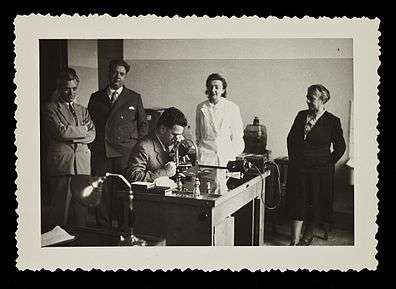Hans Grüneberg

Hans Grüneberg FRS[1] (26 May 1907 – 23 October 1982), whose name was also written as Hans Grueneberg and Hans Gruneberg, was a British geneticist. Grüneberg was born in Wuppertal–Elberfeld in Germany. He obtained an MD from the University of Bonn, a PhD in biology from the University of Berlin and a DSc from the University of London. He arrived in London in 1933, at the invitation of J.B.S. Haldane and Sir Henry Dale.
He was elected a Fellow of the Royal Society in 1956.[1] Most of his work focused on mouse genetics,[2][3][4][5][6][7][8][9][10][11][12][13] in which his speciality was the study of pleiotropic effects of mutations on the development of the mouse skeleton.
He was the first person to describe siderocytes and sideroblasts, atypical nucleated erythrocytes with granules of iron accumulated in perinuclear mitochondria.[14] This he reported in the journal Nature.[15][16][17] The Grüneberg ganglion,[18] an olfactory ganglion in rodents, was first described by Hans Grueneberg in 1973.
Career
- Honorary Research Assistant, University College London, 1933–38
- Moseley Research Student of Royal Society, 1938–42
- Captain, Royal Army Medical Corps, 1942–46
- Reader in Genetics, University College London, 1946–55
- Honorary Director of the Medical Research Council Experimental Genetics Unit at University College London, 1955–1972
- Professor of Genetics University College London, 1956–1974
- Affiliated with the Department of Pathology, Mount Vernon Hospital, Northwood, Middlesex
- Emeritus Professor University College London, from retirement, 1974
Books
- 1947. Animal genetics and medicine. Hamish Hamilton, London.
- 1952. The genetics of the mouse. 2nd ed, revised and enlarged. Nijhoff, The Hague.
- 1963. The pathology of development: a study of inherited skeletal disorders in animals. Wiley, London.
References
- 1 2 Lewis, Dan; Hunt, D. M. (1984). "Hans Gruneberg. 26 May 1907-23 October 1982". Biographical Memoirs of Fellows of the Royal Society. 30: 226. doi:10.1098/rsbm.1984.0008. JSTOR 769826. PMID 11616003.
- ↑ Grüneberg, H.; Wickramaratne, G. A. (1974). "A re-examination of two skeletal mutants of the mouse, vestigial-tail (vt) and congenital hydrocephalus (ch)". Journal of embryology and experimental morphology. 31 (1): 207–222. PMID 4819561.
- ↑ Grüneberg, H.; Lee, A. J. (1973). "The anatomy and development of brachypodism in the mouse". Journal of embryology and experimental morphology. 30 (1): 119–141. PMID 4729943.
- ↑ Grüneberg, H. (1971). "Exocrine glands and the Chievitz organ of some mouse mutants". Journal of embryology and experimental morphology. 25 (2): 247–261. PMID 5088022.
- ↑ Grüneberg, H. (1971). "The glandular aspects of the tabby syndrome in the mouse". Journal of embryology and experimental morphology. 25 (1): 1–19. PMID 5548211.
- ↑ Grüneberg, H. (1969). "Threshold phenomena versus cell heredity in the manifestation of sex-linked genes in mammals". Journal of embryology and experimental morphology. 22 (2): 145–179. PMID 5361553.
- ↑ Grüneberg, H. (1966). "More about the tabby mouse and about the Lyon hypothesis". Journal of embryology and experimental morphology. 16 (3): 569–590. PMID 5962700.
- ↑ Grüneberg, H. (1966). "The molars of the tabby mouse, and a test of the 'single-active X-chromosome' hypothesis". Journal of embryology and experimental morphology. 15 (2): 223–244. PMID 5959976.
- ↑ Grüneberg, H. (1965). "Genes and genotypes affecting the teeth of the mouse". Journal of embryology and experimental morphology. 14 (2): 137–159. PMID 5893447.
- ↑ Gruneberg, H. (1958). "Genetical studies on the skeleton of the mouse. XXIII. The development of brachyury and anury". Journal of embryology and experimental morphology. 6 (3): 424–443. PMID 13575656.
- ↑ Gruneberg, H. (1958). "Genetical studies on the skeleton of the mouse. XXII. The development of Danforth's short-tail". Journal of embryology and experimental morphology. 6 (1): 124–148. PMID 13539275.
- ↑ Grüneberg, H.; Burnett, J. B.; Snell, G. D. (1941). "The Origin of Jerker, a New Gene Mutation of the House Mouse, and Linkage Studies Made with It". Proceedings of the National Academy of Sciences of the United States of America. 27 (12): 562–565. doi:10.1073/pnas.27.12.562. PMC 1078382
 . PMID 16588504.
. PMID 16588504. - ↑ Grüneberg, H. (1939). "Inherited Macrocytic Anemias in the House Mouse". Genetics. 24 (6): 777–810. PMC 1209073
 . PMID 17246952.
. PMID 17246952. - ↑ medical-dictionary
- ↑ Grüneberg, H. (1970). "Is there a viral component in the genetic background?". Nature. 225 (5227): 39–41. doi:10.1038/225039a0. PMID 5410193.
- ↑ Gruneberg, H. (1956). "A ventral ectodermal ridge of the tail in mouse embryos". Nature. 177 (4513): 787–788. doi:10.1038/177787b0. PMID 13321960.
- ↑ Grüneberg, H. (1954). "Variation Within Inbred Strains of Mice". Nature. 173 (4406): 674–676. doi:10.1038/173674a0. PMID 13165620.
- ↑ Grüneberg, H. (1973). "A ganglion probably belonging to the N. Terminalis system in the nasal mucosa of the mouse". Zeitschrift für Anatomie und Entwicklungsgeschichte. 140 (1): 39–52. PMID 4749131.